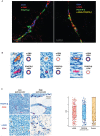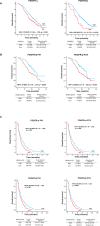Survival-associated heterogeneity of marker-defined perivascular cells in colorectal cancer
- PMID: 27248825
- PMCID: PMC5173107
- DOI: 10.18632/oncotarget.9632
Survival-associated heterogeneity of marker-defined perivascular cells in colorectal cancer
Abstract
Perivascular cells (PC) were recently implied as regulators of metastasis and immune cell activity. Perivascular heterogeneity in clinical samples, and associations with other tumor features and outcome, remain largely unknown.Here we report a novel method for digital quantitative analyses of vessel characteristics and PC, which was applied to two collections of human metastatic colorectal cancer (mCRC).Initial analyses identified marker-defined subsets of PC, including cells expressing PDGFR-β or α-SMA or both markers. PC subsets were largely independently expressed in a manner unrelated to vessel density and size. Association studies implied specific oncogenic mutations in malignant cells as determinants of PC status. Semi-quantitative and digital-image-analyses-based scoring of the NORDIC-VII cohort identified significant associations between low expression of perivascular PDGFR-α and -β and shorter overall survival. Analyses of the SPCRC cohort confirmed these findings. Perivascular PDGFR-α and -β remained independent factors for survival in multivariate analyses.Overall, our study identified host vasculature and oncogenic status as determinants of tumor perivascular features. Perivascular PDGFR-α and -β were identified as novel independent markers predicting survival in mCRC. The novel methodology should be suitable for similar analyses in other tumor collections.
Keywords: PDGFR; cancer associated fibroblasts; colorectal cancer; perivascular cells; tumor stroma.
Conflict of interest statement
The authors declare no conflicts of interest.
Figures




References
-
- Armulik A, Genove G, Betsholtz C. Pericytes: Developmental, Physiological, and Pathological Perspectives, Problems, and Promises. Dev Cell. 2011;21:193–215. - PubMed
-
- Dulauroy S, Di Carlo SE, Langa F, Eberl G, Peduto L. Lineage tracing and genetic ablation of ADAM12(+) perivascular cells identify a major source of profibrotic cells during acute tissue injury. Nat Med. 2012;18:1262–1270. - PubMed
-
- Goritz C, Dias DO, Tomilin N, Barbacid M, Shupliakov O, Frisen J. A Pericyte Origin of Spinal Cord Scar Tissue. Science. 2011;333:238–242. - PubMed
Publication types
MeSH terms
Substances
LinkOut - more resources
Full Text Sources
Other Literature Sources
Medical
Miscellaneous

